by Winding Pathways | Dec 3, 2020 | (Sub)Urban Homesteading, Garden/Yard, Mammals, Nature, Pests
What a year this has been! Coronavirus altered the lives of nearly everyone. Many of us now work from home and spend the day staring at a computer screen and attending zoom meetings.
A delight of working from home is entertainment right outside the window. Sometimes we take our eyes off the screen, glance outside, and grin as we watch chipmunk antics.
No Need To Feed
We don’t really feed our chipmunks. They’re opportunists. When chickadees, nuthatches and other birds drop seeds from hanging feeders the chippies are right there filling their cheeks with sunflower seeds and dashing off to store them in their underground burrows.
Manly people detest these small, beautiful mammals and cite the damage they do to retaining walls and lawns. Our retaining wall is crafted of huge glacial boulders. Its many nooks and crannies are perfect for chipmunks but are so sturdy chipmunks can’t damage it. They give us cheer in a perplexing year.
Many species of chipmunks live in the United States but the one most common in suburban areas between the Atlantic and the Great Plains is the Eastern Chipmunk. Almost everyone can identify this animal that only tips the scale at two to three ounces. Counting its tail, a big one might stretch a foot long.
Where Do Chipmunks Live?
Chipmunks love what biologists call “structure”. A pile of firewood or old lumber, a brush pile, a rarely used shed, or a retention wall is structure that makes a dandy home for chipmunks. They typically create an extensive subterranean home under structures that is an extensive tunnel system with several entrances to the surface.
What’s In a Name?
Chipmunks were named by the Ojibwe Tribe with the words that mean, “one who descends trees headfirst.” Climb they can! Chipmunks scamper up and down trees and bushes and easily reach our bird feeding platform. They prefer sunflower seeds and stuff their cheek pouches until they seem ready to burst. Then they scoot off to store seeds down in their tunnels. We wonder how big that pile of seeds might be! Chippies also eat wild seeds, acorns, and even an occasional insect.
During the coldest weather chippies stay underground and sleep in a kind of torpor. They don’t hibernate and probably enjoy snacking on the sunflower seeds they cashed months before. Last winter one tunneled under the snow and emerged under our bird feeder for fresh seeds.
Overall Delight
We love watching our chipmunks chase one another up, down and around the feeder and retaining wall. Suburban chipmunks are fortunate. Snakes and raptors love snacking on them but people keep long, skinny reptiles out of yards and not many hawks venture near homes. Since chipmunks are day shift animals our barred owls don’t get a crack at them because they work the night shift.
So, in exchange for a safe place to eat, a scoop of seeds daily, and a cozy retaining wall to burrow in, our chipmunks give us a humorous and interesting break from working at home chores. CBS recently aired a short on a food editor who, during Coronavirus time has catered to a chipmunk outside her home. Sweet and tender show!
-
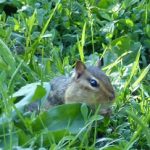
-
Foraging for seeds.
-
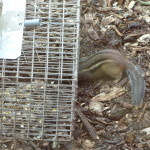
-
Having excavated, the chipmunk now enters the tunnel to get the corn.
-
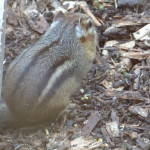
-
The chipmunk figured how to tunnel under the live trap, gather up the corn and emerged with pouches full.
-
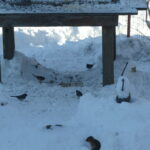
-
Chipmunks forage under the bird feeding platform.
by Winding Pathways | Oct 22, 2020 | (Sub)Urban Homesteading, Mammals, Pests
Early one September morning a disturbing sight greeted us. The metal post holding a suet feeder high off the ground was bent. The feeder was gone. After a search we finally found it where our nocturnal thieves had abandoned it after devouring the suet.
Many people are frustrated when daytime squirrels gobble up feeder seed, but other mammals visit feeders unseen after sunset. Not all are as rough on feeders as raccoons and all night visitors are interesting but they can also be frustrating.
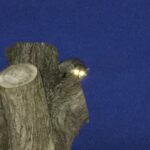
Raccoons are strong and hungry.
Up in the wee hours sleepless or just to get a snack? Shine a flashlight beam on the feeder. You may spot raccoons, deer, flying squirrels, or even a bear! They all like birdseed and some relish suet.
Raccoons live nearly everywhere, even in big cities. Our son once sent a picture he took of one raiding a dumpster in New York City. Occasionally they are out on cloudy days but mostly they are nocturnal.
Raccoons are common, numerous, powerful, and gregarious. Sometimes a whole family visits a feeder after dark. Excellent climbers, if they can’t shinny up a slippery metal pole to reach seed, they might just bend it over as they did at Winding Pathways. They love suet but also eat corn, sunflower seeds, and many other foods people put out for birds.
One of the most endearing animals to visit feeders are flying squirrels. There are two species but both are nocturnal and are almost never seen during daylight. Flying squirrels often live in big dead hollow trees and are more common than most people realize.
Flying squirrels are misnamed mammals. They can’t fly. They should be called gliding squirrels, for they spread loose skin on their sides and glide from the top of a tree to the ground – or bird feeder. These mammals weigh only about two ounces, about half that of an Eastern chipmunk. In comparison, a mature gray squirrel is ten times heavier at about 20 ounces.
Flying squirrels are shy and beautiful. Seeing one is a thrill.
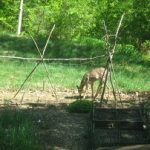
Deer In Garden Photo by S. Fehsinger
Like raccoons and flying squirrels, deer love birdseed. Sometimes they visit during the day but we see them more often after dark. If a feeder is well seed stocked in the evening but is empty come morning deer are likely culprits. Look for their tracks and droppings to confirm the visit.
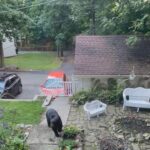
Bears make themselves at home anywhere.
Bears
Gads. Bears at the feeder! Could be. We don’t live in bear country but they are common over much of the United States. Mostly nocturnal, they love birdseed and suet. A 300-pound bear can rip down the most armored feeder and they’re skilled trash can scroungers as well.
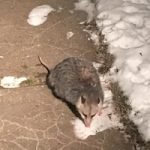
A ‘possum snuffling for food. Photo J. Jones
Skunks, Possums, and Rats
Skunks, opossums, and Norway Rats all love birdseed. Like flying squirrels and raccoons, they are nocturnal. Skunks and possums are native animals that can be comical, but no one wants rats around. They are dangerous pests capable of spreading disease and gnawing on houses.
REDUCING NOCTURNAL FEEDER VISITORS
There’s an effective way to discourage nocturnal feeding wildlife. It’s a two-step process:
- Only put out the amount of seed birds are likely to eat in a day. Empty feeders may attract nocturnal animals but pickings are slim and discouraging.
- Better yet bring all feeders inside by sunset. Store them overnight in a metal trash can with a tight-fitting lid to keep mice from being tempted to raid it even if it’s indoors.
Feeding birds is entertaining and educational. We love having colorful activity just outside our window. We’re not thrilled when raccoons tear up the feeders, so when midnight raiders help themselves, we bring feeders in each evening.
by Winding Pathways | Jul 16, 2020 | Garden/Yard, Mammals, Pests
What to Do About Raccoons
One June morning we peered out our dining room window to see bird feeder carnage. The shepherd’s hook that holds up suet and seed feeders were bent and the board it was anchored in shattered. The feeders were gone. One we later found in the little pond we have. We were frustrated and a bit angry.
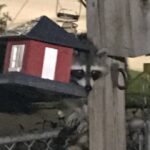
Raccoons are skillful climbers. (Jill photo)
Raccoons were the culprits. Several had raided the night before. Young raccoons are loved everywhere for their “cuteness”. We like them too, but damage can’t be ignored, so we took action.
Amazing Animals
Raccoons are amazingly successful animals. They live nearly everywhere in the continental United States and southern Canada. A few years ago, our son sent us a photo he snapped of a raccoon in a dumpster in our nation’s largest city. They thrive in urban, suburban, and rural areas, especially those that have streams, rivers, or lakes nearby and denning places. Those could be hollow trees, road culverts, or even barns, garages, and house attics.
Raccoons were released in Russia and Japan, where they thrive and are expanding their range. Away from North America they are an invasive species causing ecological problems and probably raiding chicken coops and bird feeders in their new countries.
What do Raccoons Eat?
They are successful, in part, because of their eclectic diet. True omnivores, raccoons enjoy dining on carrion, frogs, crayfish, mice, dog and cat food, birdseed, fruit, and a host of other things, even human food scraps tossed in trash cans.
How We Foil the Raccoons
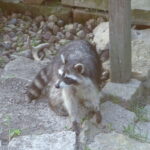
Raccoons forage wherever they find food.
We don’t want to physically harm the raccoons that damaged our bird feeding station so we are doing these things:
- Only put out as much seed as birds eat during the day, so night prowling raccoons find none to munch on. They move on.
- Bring silo, suet and hummingbird feeders inside each evening, so they’re not out to temp nocturnal animals.
- We don’t have a cat or dog but if we did, we would keep their food inside where raccoons cannot get to it.
- We close the sturdy doors that keep raccoons out of our chicken house at night. We’ve also installed heavy wire mesh over the coop’s windows.
- We feed food scraps to our chickens and compost what the hens won’t eat in a “tight” compost bin that raccoons can’t enter. Fortunately, chickens devour the foods raccoons love and shun foods that raccoons also don’t eat. If we had to put food scraps in the garbage, we’d keep the can in the garage where wildlife can’t access it.
Capturing the Culprit
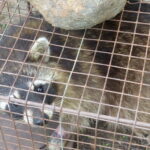
This raccoon readily entered the box trap to eat the sardines.
The night after the raccoons ruined our feeders, we did one other thing. We have a metal box trap that catches, but doesn’t harm, animals. We set it near the feeder with a sardine for bait. A big raccoon went right in. We let him stay there for a while so he could ponder his captivity. Then we sprayed him with water from the hose and opened the trap. He zoomed out like greased lightning, but he may have enjoyed the stay. It was a hot night and the hose water probably cooled him down. We hope he remembers being confined for a short while and stays away.
So far, these actions have worked. Our chickens are healthy and safe. And, no damage to feeders will happen when raccoons prowl.
by Winding Pathways | Apr 16, 2020 | (Sub)Urban Homesteading, Garden/Yard, Nature, Pests
Lyme Disease is something you just don’t want. Rich has had it twice. It was no fun, and he was lucky. Nearly as soon as symptoms appeared, he visited our family physician. She prescribed a powerful antibiotic that worked wonders and left him with no lingering problems. Unfortunately, many Lyme Disease victims suffer pain and fatigue for years. It’s serious.
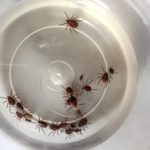
Collection of ticks
Lyme is often transmitted to a human from a bite by a tiny tick that picked up the disease bacteria from an infected white-footed mouse. It once was thought that deer were the primary carrier but mostly they are host to a tiny larval tick that infects a mouse that allows another tick to infect a person.
In theory, eliminating white-footed mice from a yard and home will greatly reduce the odds of transmission of this disease to people. Killing all of them isn’t feasible but reducing their numbers is.
About White-Footed and Deer Mice
White Footed and Deer Mice are amazingly common across much of North America. They’re the cute, native mouse, not to be confused with the common house mouse that originated in the Old World.
White Footeds naturally live in dry temperate forests with brush. That perfectly describes suburban landscaping. It’s likely that five to 20 white-footed mice live in close proximity to most suburban families. They’re nocturnal and rarely seen.
Here are some characteristics:
- They’re hoarders. Find a cache of corn, dog food, or acorns in a shoe or empty can and you’ve found a white-footed mouse cache.
- They reproduce like crazy. A 44-day old female can become pregnant and bear a litter after 22 to 28 days. Babies become independent in three weeks and soon begin having their own babies. Mom often has two to four litters a year.
- They don’t live long. A year-old mouse is elderly.
- Foxes, weasels, hawks, owls, coyotes, and many other predators love dining on mice.
- White Footed mice enjoy coming into homes, where they often find food and enjoy a furnace’s warmth. They can bring with them disease-bearing ticks.
Prudent homeowners carefully manage ticks, in part by reducing white-footed mice numbers. The fewer mice that live near people the lower the odds a person will contract Lyme Disease. So, managing mice and ticks makes for a healthier home and yard. Here are a few tips:
To reduce mouse populations and entry to homes:
- Welcome mouse predators. Karla Bloem, Executive Director of the International Owl Center says, “Two actions people can take to encourage owls are to protect large dead trees that aren’t a threat to people of buildings should they fall. Owls love them. Also, building and erecting an owl house can welcome owls to live near a home and catch and eat mice.” Barred owl nest box plans, and plans for many other birdhouses, can be found at www.nestwatch.org.
- Plug up holes that allow mice to enter a home and replace worn or broken weatherstripping. This is an important fall maintenance that also keeps cold drafts outside and reduces heating bills.
- Avoid feeding mice. They love dining on dog or cat food left in a dish overnight or birdseed left under a feeder. Only feed pets and wild birds what they can eat in a short time. Then, pick up and clean the pet bowl.
- Use snap traps to kill mice in the house. Avoid poison. A poisoned mouse can stagger outside to be caught and eaten by an owl, which can sicken or die from the poison.
A Few More Ways to Reduce Lyme Disease
In addition to reducing mouse numbers and applying a vaccine to keep survivors free of Lyme Disease bacteria here are a few other ways a person can do to reduce odds of infection:

Pants, boots, gaiters and insect repellents help protect from ticks.
Use Permethrin: When applied to clothing, not skin, this chemical repels and kills ticks. Rich purchased several sets of clothing from the Insect Shield Company that are impregnated with permethrin. Supposedly the tick-killing effectiveness lasts for 70 washings. The chemical is also available in spray cans to apply to any clothing.
Do Tick Checks: After being outside, strip down and check the body over for ticks. Then take a hot sudsy shower. Ticks usually crawl around on a person for several hours before biting. A tick merely walking on the skin can’t infect a person.
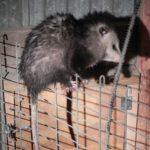
Opossums groom themselves carefully.
Thank and welcome opossums: New research indicates that opossums are tick vacuum cleaners. Ticks climb on them, but these primitive mammals groom often and eat the ticks they remove from their fur and skin. If you have a possum living in the yard be happy.
An Emerging Tool in the Battle Against Lyme Disease
A new product is being developed and tested by a major research company. It is an oral nontoxic vaccine placed in small baits. When strategically positioned around a yard, mice not yet infected with Lyme bacteria eat it and become resistant to the bacteria. Mice uninfected by Lyme can’t spread the disease to a person. If all goes well this product will be on the market by 2021 and may be a major help in reducing human cases of Lyme Disease.
Lyme Disease is an awful condition. Taking precautions to reduce the odds of being infected makes sense.
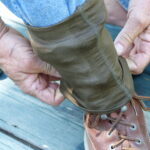
gaiters with tick guard help repel ticks.
by Winding Pathways | Sep 5, 2019 | Nature, Pests
Sometimes the best of intentions turn into a nightmare. A plant down the road from Winding Pathways is proof.
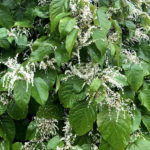
Beware the beauty of Japanese Knotweed.
In the 1840s Philipp Franz von Siebold was in Nagasaki, Japan, and believed a common native plant was so useful and interesting that it should be shared with the world. He shipped cuttings to the Netherlands. The plant thrived and soon gardeners were planting it because of its attractive reddish young leaves, hollow stems somewhat like bamboo, and its showy white flowers that bloom in September. Young shoots are even edible somewhat like asparagus in early spring.
Von Siebold thought he was doing a good thing by bringing this plant to Europe, but soon gardeners realized it was a rapidly spreading monster that crowded out more valuable vegetation. The World Conservation Union calls it one of the worst of the invasives.
It arrived in the United States in the late 1800s as a desirable garden plant, and soon it was found wild in at least 39 states. It’s an invasive problem in England, New Zealand, the United States, and many other countries.
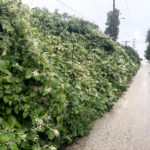
Knotweed forms dense patches and spreads with rhizomes.
Japanese knotweed forms colonies so dense they crowd out all other plants. Rhizomes spread horizontally under the soil surface and soon new plants pop up from them. Early spring shoots have a reddish cast. Leaves are triangular, and the plants quickly grow to four or five feet tall. They are amazingly abundant along streams and lakes. In Iowa, we often see them along roads. They are especially easy to spot when their showy white blooms form in late August and continue into September.
Knotweed is an edible plant in early spring, but anyone with a garden or natural area should be cautious about bringing it home. Drop a node on the ground and it will soon sprout and grow and grow and spread and spread.
Once established Knotweed is hard to control, although continuous mowing should knock it back. It’s something to keep out of the yard, and so far, we’ve been successful at Winding Pathways.
by Winding Pathways | Dec 13, 2018 | Garden/Yard, Pests
Lots of boxelder bugs are traipsing through homes this winter to the consternation of human occupants. We reluctantly share our home with a few during cold months.
This amazingly common and crafty insect is a true bug named for common boxelder tree. You don’t have to have boxelder trees nearby to “enjoy” visits by the bug. Maples and ash trees of several species make suitable hosts. Since these trees are everywhere in suburbia it’s no wonder boxelder bugs pester so many people. The insect makes its living feeding on tree seeds and sap yet poses no threat to its host. Unlike the pests of many other trees, boxelder bugs don’t kill trees.
Come fall box elder bugs prepare for cold weather by tucking themselves into bark crevices to patiently wait out the cold. However, they would rather be warm. If a house is nearby, they seem to sense that soon the furnace will be going and indoors is the best place to overwinter.
How Boxelder Bugs Get In
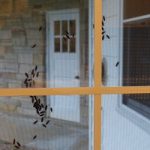
All this winter box elder bugs have gathered on warm sunny sides of homes.
Although they are fairly large insects boxelder bugs can crawl through tiny cracks and holes. Often, they swarm in the sun on the exterior of a house and some manage to find their way inside. Winter is spent idly exploring light fixtures, furniture, and walls.
They are not really a serious pest. Pesky might be a better way to describe them. Boxelder bugs neither bite nor sting. They do sometimes crawl on people and pets. Perhaps their most disagreeable characteristics are pooping and emitting a disagreeable odor if they are crushed. It’s this bad odor that protects them from predators. Hardly anything will eat a boxelder bug.
Getting Rid of Boxelder Bugs in Your Home
Want to rid the house of boxelder bugs? The best defense is a caulking gun. Late each summer seal up cracks that allow them to squeeze into the house. Look for cracks and holes around window and door frames and around wires and pipes leading into the home. Bugs discovered wandering around inside can be vacuumed up, and a shop vac can suck up hundreds sunning on the exterior. Dump them in soapy water and they’ll quickly drown. A hose can also knock them off an exterior wall. Insecticides kill them but perhaps create more problems than they solve. Some people report that spraying them with soapy water also kills them.
We’ve had some success at Winding Pathways in reducing the number of bugs we pick off walls and windows in the winter. We used to bring in a week’s worth of firewood and stack it near the woodstove. For years we didn’t realize boxelder bugs were hiding in the wood. Once they warmed up the insects set out exploring the house. Now we leave wood outside and only bring in a few pieces that go directly into the stove. It’s reduced, but not eliminated, the number of boxelder bugs inside.
Boxelder bugs aren’t harmful, but they are pesky and goofy. Caulking a home’s cracks can encourage them to winter outdoors in trees, rather than in homes. One speaker on Science Fridays quipped, “Boxelder bugs have nowhere to go and all day to get there.”


















